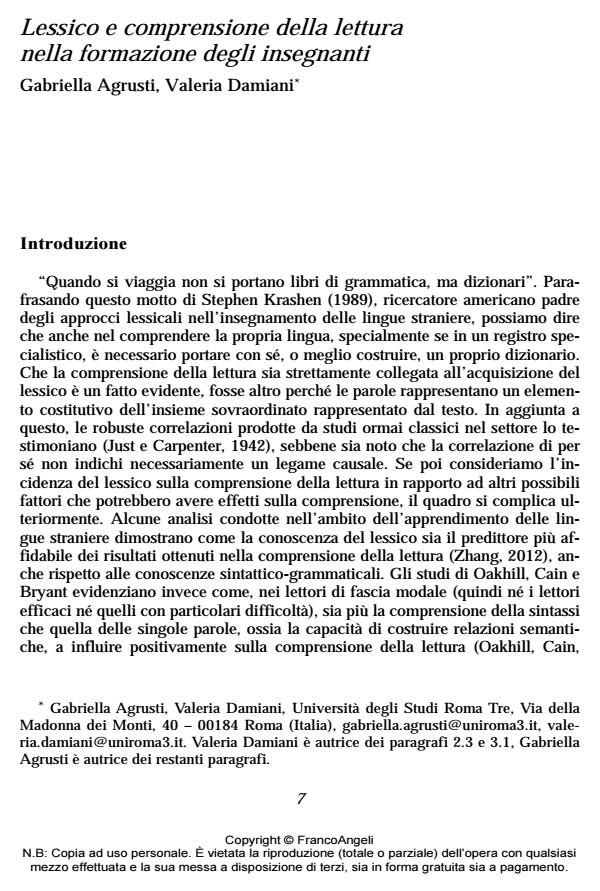Lessico e comprensione della lettura nella formazione degli insegnanti
Titolo Rivista CADMO
Autori/Curatori Gabriella Agrusti, Valeria Damiani
Anno di pubblicazione 2014 Fascicolo 2014/1
Lingua Italiano Numero pagine 18 P. 7-24 Dimensione file 90 KB
DOI 10.3280/CAD2014-001003
Il DOI è il codice a barre della proprietà intellettuale: per saperne di più
clicca qui
Qui sotto puoi vedere in anteprima la prima pagina di questo articolo.
Se questo articolo ti interessa, lo puoi acquistare (e scaricare in formato pdf) seguendo le facili indicazioni per acquistare il download credit. Acquista Download Credits per scaricare questo Articolo in formato PDF

FrancoAngeli è membro della Publishers International Linking Association, Inc (PILA)associazione indipendente e non profit per facilitare (attraverso i servizi tecnologici implementati da CrossRef.org) l’accesso degli studiosi ai contenuti digitali nelle pubblicazioni professionali e scientifiche
It is widely recognized that vocabulary is closely tied to reading comprehension, and correlations between these two constructs, even if differently defined across studies, vary between .6 and .8. But correlation is not a causal relationship, and does not provide enough basis for a comprehensive conceptual explanation. Reversing the problem, it is still highly controversial whether specific interventions on vocabulary instruction can massively influence reading comprehension, and this particularly in adult learners, indicating that a lot remains to be investigated in the field of vocabulary knowledge transfer to other components of language proficiency. Recent studies showed that the weak link for understanding this apparent gap lies probably in the way vocabulary is assessed. This article shows the results of a two-year research project aimed at assessing future teachers’ vocabulary related to school everyday life issues, focussing both on language for specific purposes and on general language. In particular, different typologies of reading comprehension tests, of vocabulary tests (receptive and productive), on paper and pencil and on computer-based administrations, were adopted and compared.
Parole chiave:Vocabulary, reading comprehension, teacher education, assessment, error analysis.
- Agrusti, F., Vertecchi, B. (2007), “TestMaker. Un programma per misurare la capacità di comprensione della lettura”, Cadmo Giornale Italiano di Pedagogia sperimentale. An International Journal of Educational Research, 15 (1), pp. 119-121. Ambel, M., Faudella, P. (2000), La capacità di scrittura negli esami di Stato. Milano: FrancoAngeli.
- Arnaud, P. (1989), “Vocabulary and Grammar: A Multitrait-multimethod Investigation”, AILA Review, 6, pp. 56-65.
- Birr Moje, E., Stockdill, D., Kim, K., Kim, H. (2011), “The Role of Text in Disciplinary Learning”, in M. Kamil, P.D. Pearson, E. Birr Moje, P. P. Afflerbach, Handbook of Reading Research. New York: Routledge, vol. IV, pp. 453-486.
- Chapelle, C.A. (1994), “Are C-tests Valid Measures for L2 Vocabulary Research?”, Second Language Research, 10, pp. 157-187.
- Coxhead, A. (2000), “A New Academic Word List”, TESOL Quarterly, 34, pp. 213-238.
- Cronbach, L.J. (1942), “An Analysis of Techniques for Diagnostic Vocabulary Testing”, Journal of Educational Research, 36 (6), pp. 206-217.
- Davis, F.B. (1942),“Two Measures of Reading Ability”, Journal of Educational Psychology, 33, pp. 365-372.
- De Mauro, T. (1985), Guida all’uso delle parole. Parlare e scrivere semplice e preciso per capire e farsi capire, Roma: Editori Riuniti, pp. 31-36.
- Dolch, E.W., Leeds, D. (1953), “Vocabulary Tests and Depth of Meaning”, Journal of Educational Research, 1, pp. 181-189.
- Eco, U. (1994), Sei passeggiate nei boschi narrativi. Milano: Bompiani.
- Ferreri, S. (2005), L’alfabetizzazione lessicale. Studi di linguistica educativa. Roma: Aracne.
- Just, M.A., Carpenter, P.A. (1987), The Psychology of Reading and Language Comprehension. Boston: Allyn & Bacon.
- Krashen, S. (1989), “We acquire Vocabulary and Spelling by Reading: Additional Evidence for the Input Hypothesis”, The Modern Language Journal, 24, pp. 237-270.
- Mckeown, M.G., Beck, L., Omanson, R., Pople, M. (1985), “Some Effects on the Nature and Frequency of Vocabulary Instruction on the Knowledge and Use of Words, Reading Research Quarterly, 20, pp. 222-235.
- Nagy, W.E. (1988), Teaching Vocabulary to improve Reading Comprehension. Newark: International Reading Association.
- Nagy, W.E., Scott, J.A. (2000), “Vocabulary Processes”, in M.L., Kamil, P. Mosenthal, P.D.
- Pearson, R. Barr, Handbook of Reading Research. Mahwah, NJ: Erlbaum, pp. 269-284.
- Nation, I.S.P. (1990), Teaching and Learning Vocabulary, New York: Heinle and Heinle.
- Oakhill, J.V., Cain, K., Bryant, P.E. (2003), “The Dissociation of Word Reading and Text Comprehension: Evidence from Component Skills”, Language and Cognitive process, 18 (4), pp. 443-468.
- Raimondi, E. (2007), Un’etica del lettore. Bologna: il Mulino.
- Read, J. (2000), Assessing Vocabulary. Cambridge: Cambridge University Press.
- Sposetti, P. (2008), L’italiano degli studenti universitari. Roma: Homolegens.
- Stefinlongo, A. (2002), I giovani e la scrittura. Roma: Aracne.
- Tonfoni, T., Tassi, G. (1990), La lettura strategica. Tecniche cognitive per leggere di più e meglio. Milano: Mondadori.
- Vertecchi, B. (2003), Manuale della valutazione. Analisi degli apprendimenti e dei contesti. Milano: FrancoAngeli.
- Vertecchi, B., Poce, A., Angelini, C., Agrusti, F. (2010), Orbis Dictus. A Self-Adaptive Environment for Multi-language for Teaching and Learning Opportunities. Milano: FrancoAngeli.
- Anderson, C., Freebody, P., “Vocabulary knowledge” (1981), in J.T. Guthrie (ed.), Comprehension and Teaching: Research Reviews. Newark: International Reading Association, pp. 77-117.
- Agrusti, F. (2010), “From LexMeter to Adapter. Towards a Match up between the Virtual and the Real Reader”, Cadmo. Giornale Italiano di Pedagogia sperimentale. An International Journal of Educational Research, 18 (1), pp. 97-108.
- Vertecchi, B. (2012), Parole per la scuola. Milano: FrancoAngeli.
- Zhang, D. (2012), “Vocabulary and Grammar Knowledge in Second Language Reading Comprehension:
- A Structural Equation Modeling Study”, The Modern Language Journal, 96 (4), pp. 558-575.
Gabriella Agrusti, Valeria Damiani, Lessico e comprensione della lettura nella formazione degli insegnanti in "CADMO" 1/2014, pp 7-24, DOI: 10.3280/CAD2014-001003